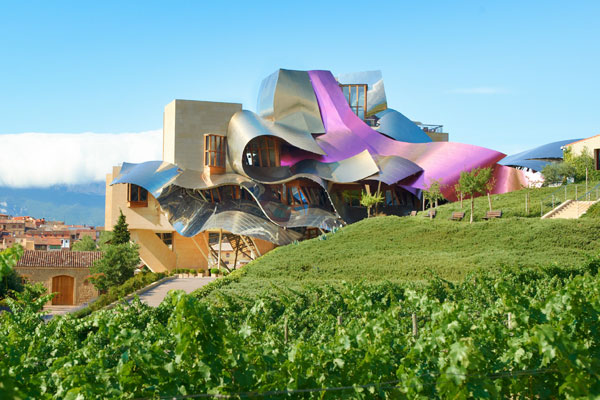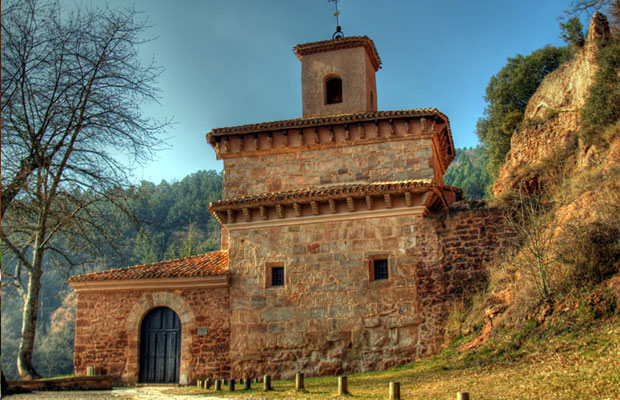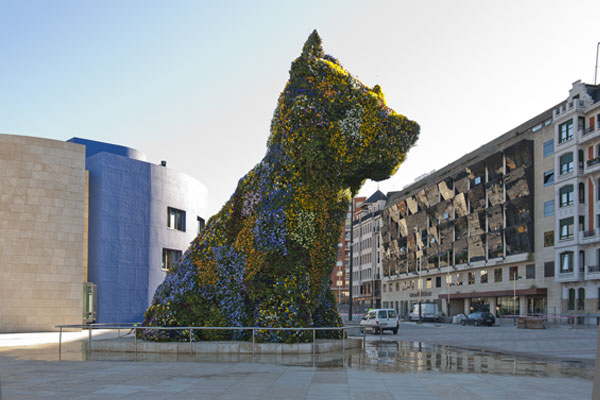Its excellent location in Azofra makes it the ideal destination for those travellers eager to enjoy a few days of rest and the countless attractions offered in the surrounding areas, i.e., its cultural heritage, food richness, landscapes et warm-hearted people. The most adventurous travellers will also find high-risk sports and leisure activities such as horseriding, cycling, skiing, 4 x 4, hiking, hot air balloon rides, private aircraft flights, etc.
This splendid construction of valuable architectural features, dating back to the end of the 17th century, stands just next to the pilgrim hostel. The Hotel Real Casona de las Amas, which is located in the Calle Mayor (main street), right on the way to Santiago, is very much influenced by the road to Santiago.
The hotel is located only 7 km from the spectacular Rioja Alta Golf Course in Cirueña. Close to Ezcaray, with its revamped ski resort, and to the prestigious Dinastía Vivanco wine museum. Besides, the Real Casona de las Amas finds itself on the main wine and monastery road. A little more than an hour away, you will be able to visit the fabulous GuggenheimMuseum of Bilbao, close to magnificent beaches.
Real Casona de las Amas es su hotel boutique en pleno corazón de La Rioja
WINERIES IN LA RIOJA
La Rioja is well-known for its wines. Wherever they go, travellers will encounter the wine culture.
The landscapes of La Rioja stand out for their extraordinary beauty, with centenary vineyards that visitors can admire. The most daring will enjoy them by bike, on horseback, and even from the air in a balloon or a plane.
There are many wineries that open their doors to those interested in getting to know the traditional wine-making process. Enjoying a tasting-session will allow you to appreciate all its subtle differences and understand why wine is something more than just a gastronomic product.
Besides, given their architecture, the wineries as such are also tourist attractions. The Bodega Marqués de Riscalis a famous one. An authentic wine city designed by Frank Gehry, is located in the nearby Alava town of El Ciego, only 18 km from the hotel. See also the Bodegade Ysios, designed by Santiago Calatravaclose to Laguardia, a medieval villageof great beauty just 30 km from the hotel.

GOLF CLUB RIOJA ALTA
If you are into the practice of golf, just ten minutes away from the Hotel Real Casona de las Amas is this splendid course.
Ubicado en la localidad de Cirueña, el Club de Golf Rioja Alta cuenta con uno de los recorridos de juego más bellos y versátiles del norte de España, compuesto por 18 hoyos de par 72, dispuestos alrededor de una extensa área de bosques con robles centenarios y magníficos lagos. It includes a field of Practice, Approach and Putting Green. Its facilities also comprise of a cafeteria and restaurant service and a social area of cosy lounges.
NATURE AND LOCALITIES
Landscapes, valleys, rivers and mountains are part of the natural beauty of La Rioja. For walkers and nature lovers, the areas of the valley are one more reason to come and visit. The Ebro River, on its way through the region, has generated seven valleys of great attractiveness with its peculiar localities. The Iberian flora and fauna of the Sierra de la Demanda and the trekking routes through the Sierra Cebollera Natural Park that run between lakes, waterfalls and the always beautiful vineyards are of great interest.
The local towns deserve a special mention for their beauty: the capital itself Logroño, Santo Domingo de la Calzada, Briñas, Calahorra, Najera and Arnedillo. All of them should be visited to discover their history, people and folklore that are closely linked to the wine culture. An example of this is the famous Battle of wine that is celebrated in Haro.

VIVANCO MUSEUM OF WINE CULTURE
Located in the beautiful town of Briones, only 15 km from the Hotel Real Casona de las Amas.
The museum is the best place to realize the importance of wine in La Rioja. In its extensive facilities, the tourist will find numerous works of art and objects related to the world of wine. It includes permanent and temporary exhibitions, as well as the famous Garden of Bacchus where more than two hundred varieties of vines from all over the world have been planted. A museum to entertain oneself in the history of wine as an element present in different cultures. As a complement to your visit, you will have the possibility to enjoy a tasting-session of its wines and a well-thought-out gastronomic offer.
ROUTE TO SANTIAGO DE COMPOSTELA
Coming from Navarre, the Jacobean route that goes from Roncesvalles to Santiago de Compostela makes 3 stops in La Rioja. There are three routes of remarkable beauty that allow the pilgrim to make a variant to know the Monasteries of Yuso and Suso in San Millán de la Cogolla.
The three routes make their first stop in Logroño, capital of La Rioja, where you can learn about the history of this small city and its many attractions of all kinds such as the famous Calle Laurel, an essential gastronomic route. Later, the Camino de Santiago continues towards Nájera and Santo Domingo,ending in Grañón, the last Rioja stop before heading one’s way through Burgos.

EZCARAY AND VALDEZCARAY
Very close to the Hotel Real Casona de las Amas is Ezcaray, Ezcarayone of the most beautiful towns in the entire Rioja community.
A small municipality north of the Oja River Valley, in the Sierra de la Demanda. It features an urban set of squares, arcades and palacetes of the 18th century, such as Torremuzquiz, which is one of the best preserved and most beautiful in La Rioja. You will also see the Royal Tapestry Factory of Santa Bárbara, founded in 1752, very close to an area of beautiful gardens and bridges over the river.
From the town itself you have a view over the highest peak of La Rioja, San Lorenzo, where the Valdezcaray Ski Station is located. (http://www.valdezcaray.es/). Above 1 500 meters of altitude, and with a maximum height of 2 125 meters, this sports resort provides a perfect climate for skiing. It is composed of more than twenty tracks of all kinds, ski lifts, almost 1 500 parking places and endless amenities for ski-lovers..
DE SUSO AND YUSO MONASTERIES
San Millán de la Cogolla is where the Castilian language was born. Being considered as the cradle of the Castilian language, San Millán has been declared a World Heritage Site. This small town is only 12 km from our hotel and its cultural interest lies in the two monasteries it houses, Suso and Yuso.
The monastery of Suso dates back to 6th century. Although being from the Visigothic period, it has undergone alterations in the Mozarabic and Romanesque styles over time. This is where the first Castilian poet, Gonzalo de Berceo, lived, and where the Emilianenses Glosses, predecessors of what is known today as the Spanish language, were written.
Yusois a large monastery set up in the 11th century, and rebuilt in the 16th, 17th and 18th centuries. It combines both the Renaissance and the Baroque styles. It is worth a visit, not only for the architectural ensemble but also for the treasures you will find inside: chests, boxes, paintings, carvings and pulpits of great value. The Library and the Archive keep authentic documentary treasures, original cartularies and other bibliographic oddities.

CISTERCIAN ABBEY OF CAÑAS
A tan sólo 5 Km. de nuestro encantador Hotel Real Casona de las Amas, encontramos el monasterio de Santa María de San Salvador de Cañas o monasterio de la Luz, declarado monumento histórico nacional. This abbey of Romanesque, Mudejar and Gothic styles is inhabited by nuns who belong to the Cistercian Order of San Bernardo o de Castilla. It stands out as a whole, but especially for its architectural structure and for the way the light enters the main nave and the altarpiece. Also worth mentioning are the cloister, the relics, the tomb of Doña Urraca Díaz de Haro and the Sala de las Calaveras de las once mil vírgenes..
GUGGENHEIM MUSEUM IN BILBAO
Museum of Contemporary Art designed by Frank O. Gehry. It is one of the most innovative buildings due to its curvilinear and twisted shapes, covered with limestone, glass curtains and titanium plates. Tanto el increíble aspecto exterior como su prolongación hacia el interior generan una gran expectación en si mismas pero, además, alberga exposiciones con obras de arte de gran valor pertenecientes a la Fundación Guggenheim y otros artistas itinerantes.
Many visitors who come to Bilbao to visit the works exhibited inside and the structures of this incredible building. Louise Bourgeois’s haunting spider-shaped sculpture called Mamá, outside the museum, as well as Jeff Koons’ colorful Puppy, in the entrance, covered in natural flowers, are among its most famous masterpieces.




















